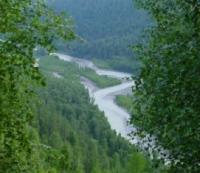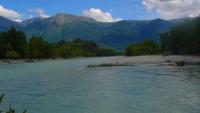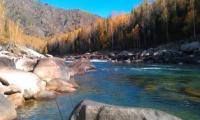You are here
Bukhtarma river.




Rafting on Bukhtarma river.
“Altai Peaks - accumulation of ice,
Water breaks down and sparkles.
We made it electricity
And the earth began to shine like a star”
Ilyas Dzhansugurov.
Water tourism on rivers of Katon-Karagaysky district.
One of the largest rivers in Altai related to the tributaries of the Irtysh is Bukhtarma. Having arisen in the Kalba ridge, it noisily and triumphantly rolls its waters with rocky gorges, past the wooded shores, until it reaches a wide valley.
A forest is rafted along this ancient river, lovers of water tourism willingly spend their free time here. The Bukhtarma River is located on the territory of the East Kazakhstan Region, the right tributary of the Irtysh. The length of Bukhtarma is 364 kilometers, the catchment area is 12,660 kilometers.
It starts from Lake Bukhtarminsky, at an altitude of 2600 meters from the ridge of Southern Altai. It falls into the Bukhtarminsky water storage zone, the main tributaries: Belaya Berel, Sarymsakty, Turgusun and others. The relief of the area adjacent to the river valley is mountainous, rugged.
The width of the valley is 5–6 kilometers (in the constrictions 0.3 – 0.4 kilometers). Mixed food: 50 - 55% of snow, 25 - 35% of rain, 15% of ground. The average annual water consumption is 207 m / s. The Bukhtarma basin is mudflow hazardous.
In the lower reaches of the river there are objects of the energy industry, the river and its tributaries are used for irrigation and water supply of settlements. In the area of the village of Rakhmanovsky Klyuchi, located in the Bukhtarma basin, there are sources of mineral waters, a sanatorium has been built.
The river is available for small vessels. Monuments to the heroes of the Civil War were erected in settlements on the shores of Bukhtarma: Zyryanovsk, Katon-Karagai, the Urals and a number of others. One of the main tributaries of Bukhtarma - the Belaya Berel River, originates from the Berelsky glacier located on the slopes of Belukha Mountain.
The highest point of its basin is located at an altitude of 4506 m above sea level, the mouth of the Bukhtarma River lies 4 km below. At first, Bukhtarma flows in a westerly direction, but the spurs of the Tarbagatai ridge force it to deviate sharply to the north.
Cramped by the cliffs, the river rushes along the rocks with thunder, forming numerous cascades, whirlpools, and rapids. After the confluence of the right tributary - Bereli, Bukhtarma carries its waters to the south, and from the Uryl settlement - in the south-west direction.
Bukhtarma flows among an expanding mountain basin. From all sides gently sloping ridges rise, overgrown with dense deciduous and coniferous forests, behind which low snowy peaks are visible. Here the river flows along the Bukhtarma depression - an intermountain depression between the ranges of the Southern Altai (in the south) and the mountains of the right bank (in the north and east).
The valley valley is about 120 km. It consists of a system of small hollows (Katon-Karagayskaya, Urylskaya) with steppe and meadow vegetation and mountain lintels separating them, covered with deciduous and pine forests.
After the confluence of the Chernovaya and Kilmes rivers (the upper reaches of the latter are known as Sarymsakty), Bukhtarma turns to the north-west, taking the Belaya tributary and a number of others along the path on the right side.
Here Bukhtarma is a typical mountain river, which with deafening noise and a speed of 2 - 3 m / s rushes along a narrow gorge littered with rocky boulders and forested, forming almost continuous cascades of rapids inaccessible to passage.
Only with the expansion of the valley does the river become a calmer and lighter ribbon up to 30 - 70 m wide between the approaching slopes. After Quilmes, the area acquires a steppe character. From the confluence of Hamir (on the right side), Bukhtarma turns to the southwest and near the village.
Turgusun flows into the Bukhtarma reservoir. In the upper river should be extremely careful. Of particular danger here are narrow winding ducts, which in places are completely or almost completely blocked by fallen trees.
Authority:
The book "Geography of East Kazakhstan", 2005. Ust-Kamenogorsk.
Photos
Alexander Petrov.







